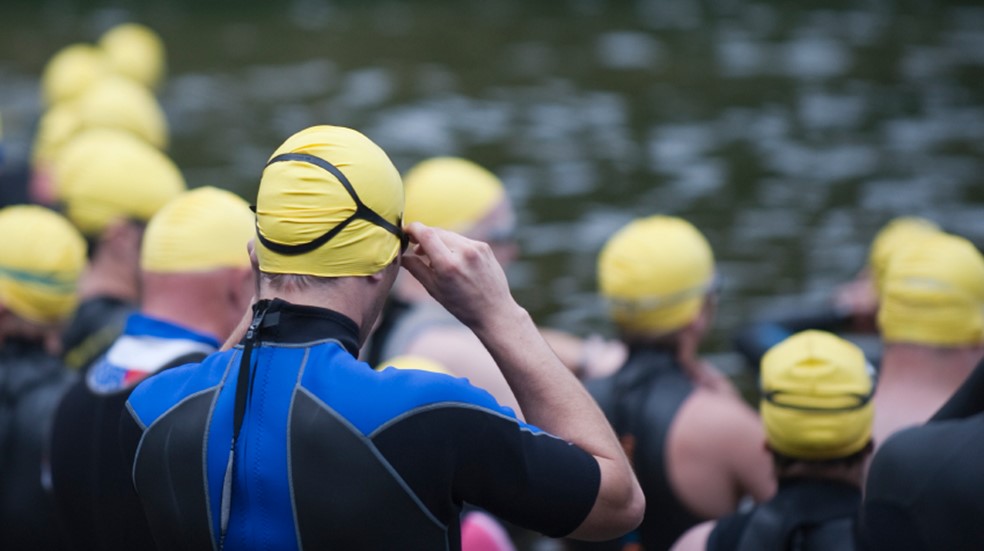|
Originally, the wetsuit was introduced to competitors in the sport of triathlon as a safety aid to help swimmers endure the cold water and prevent the onset of hypothermia. The wetsuit simply acts by allowing water to fill between the rubber of the suit and the body. During the swim of the triathlon, the temperature of the body increases which causes the water within the wetsuit to also increase. Hence, allowing triathletes to endure the cold during open water swims. Apart from benefiting from such warmer temperatures in cold water around the UK, it soon became apparent that there was an additional advantage of the wetsuit. Open water swimmers soon found that their performance in the water was improved by the increase in buoyancy from the wetsuit, giving the additional propulsive lift and height in the water that they may not have experienced in the pool without a suit. Not only are swimmers guarded against the cold water and lifted higher at the surface, but swimmers also experienced a decrease in drag and frontal resistance in the water. Thus, swimmers were swimming faster in a wetsuit (and some with better ‘distance per stroke’ than they had in the pool). How much faster?Well there is no exact answer to that question. The benefits can vary from individual to individual. It depends on various factors and also a combination of factors. Skill level is a major factor – novice swimmers often tend to benefit more from wetsuits than better swimmers. Swimmers with natural balance and buoyancy in the water tend to benefit less than swimmers with poor balance and buoyancy. The wetsuit itself plays a part – a good quality suit along with a good fit can both help with speed (so maybe the cheapest wetsuit that is too loose or way too tight isn’t the answer to maximising your potential speed – a badly fitted wetsuit can actually increase more drag). Saying this, new swimmers to the sport of triathlon often find the wetsuit very heavy and need to develop upper body strength in their stroke to cope with the suit. Personally, from experience, I believe that swimmers with a weak or problematic leg kick, benefit highly from a suit as it lifts the legs and the hips higher in the water and produces a better streamlined position (perfectly horizontal position of the whole body). Although a wetsuit will not cure a poor leg kick, it can make you feel less exhausted by your kick (however, simply wearing a wetsuit will not increase the propulsion of a weak leg kick). Be aware that some swimmers complain that the wetsuit floats their legs too high in the water which can equally disturb the propulsion of the leg kick. When experiencing choppy water (and sea swell), many people in triathlon swimming often report that all of the above benefits of a wetsuit are reduced because the benefit of height in the water is lost, along with the help of buoyancy and streamlining of the legs due to the up and down nature of the water. Reports often show that swimmers feel inhibited by the wetsuit swimming into the ‘chop’, yet aided by the prevailing wind and downward part the ‘chop’ (but overall swim times reflect a lack of help from the wetsuit, with slower swim times in choppy water as it would be without a wetsuit). What are the disadvantages of using a wetsuit?There can be a decrease in the range of motion around the shoulder joint, inhibiting rotation (depending on the suit, the fit and the swimmers flexibility). The lift of the hips from the suit can disturb the leg kick as the legs are lifted too high preventing the usual ‘connection’ to push the water backwards as the legs kick down. As already mentioned, such lift can be an advantage to others. Some swimmers feel a loss of tactile sensation on the ‘feel’ of the water during both the underwater pull and leg kick. I have seen unbalanced swimmers gain the necessary buoyancy from a wetsuit, but at the same time such buoyancy leaves them in a static, flat position, inhibiting body roll (this is often due to a lack of core strength to push down the hips during body roll). If you experience any of the above, adjustments are needed to counteract such changes in your stroke. Should your front crawl technique change in a wetsuit?As wetsuits are extremely flexible and durable these days, the mechanics of your stroke should hardly change at all (body roll, free roll of the shoulder joint, good high recovery, high elbow during the pull phase can easily be maintained). Changes to your breathing pattern will often occur in open water due to other competitors, the ‘chop’ of the water, the cold or simply oxygen deficit. What type of wetsuit?Try not to buy any old wetsuit. Find a triathlon-type, swim-specific wetsuit. The triathlon brand is not so important overall for non elite competitors; they all have good points and can help make you a faster triathlete in a open water. Go to a shop and try on various wetsuits to find the best fit irrespective of the brand – what fits you for your size, might not fit someone else of similar size. Make sure if fits around the chest, so not to take in too much water but also doesn’t over restrict breathing. Higher price suits use better neoprene material that is more flexible than cheaper suits. For example, swimming wetsuits should hold less water than surfing wetsuits (thinner and lighter material, tightly fitted). SummaryThe best method of swimming faster in your wetsuit is to train in your wetsuit and acclimatise to your stroke and the feel of the suit. Better swimmers may not get the advantage of using a wetsuit as improver swimmers. Apart from the speed benefits that some people encounter, many open water swimmers report that they feel far less exhausted after a fast swim in a wetsuit than a slow swim without one (again if the wetsuit fits and the swimmer has sufficient upper body strength to pull the added weight of the wetsuit). Speed is definitely the motivating factor as triathletes often use wetsuits in cold and warm water swims (with the lightest, tightest and most manoeuvrable wetsuits). Wearing a wetsuit in warm waters can easily dehydrate you, but luckily or sadly, that problem isn’t so apparent in the UK. Drag forces in the water can be reduced from a wetsuit, although the wetsuit cannot disguise or avoid bad stroke mechanics. If the suit fits snugly without irritating you and leaves your stroke mechanics unaffected while providing warmth and buoyancy then you should be at your fastest. If you have a low percentage of body fat, then you will particularly need the wetsuit to safeguard from hypothermia in cold water. So do wetsuits actually make you faster? There is no easy answer, hoping that you can buy a great wetsuit to faster times isn’t that simple, you still need to put in the training and develop your stroke mechanics. But there are certainly advantages and a potential speed boost for many triathletes and open water swimmers for using a good quality WETSUIT! |
AUTHORPaul started competing in swimming from the age of 8 and eventually went on to represent his country all over the world. During his time at University, Paul specialised in Aquatics and the Biomechanics of Swimming and produced numerous theses on swimming performance. TOPICS
All
ARCHIVES
June 2024
|
Let's connect!
Copyright © 2024 Strictly Swimming


